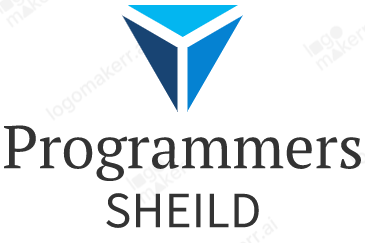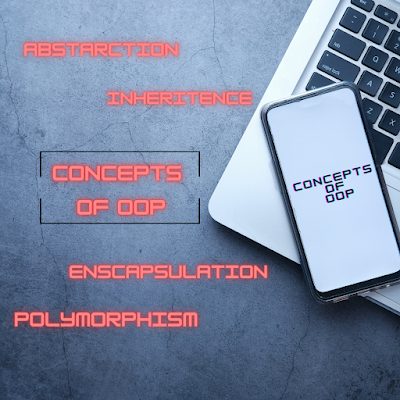oops concepts in C++
Oop is a type of programming that is a model of programming to design software by making objects. Oop stands for object-oriented Programming, This approach is basically used for creating management systems. Some languages familiar with this approach are C++, Java, and Python. Oops has some basic principles that should be followed while using this approach, oops concepts in C++ are explained below:
There are four basic concepts of oop programming:
Abstraction
Encapsulation
Polymorphism
Inheritance
Abstraction in oops
Abstraction in OOP: Simplifying Complexity for Efficient Programming
In the realm of Object-Oriented Programming (OOP), abstraction in OOP serves as a powerful tool for managing complexity and enhancing code efficiency. This SEO-friendly guide will explore the concept of abstraction in OOP, its significance, and how it facilitates streamlined programming practices.
Abstraction in OOP revolves around the keyword "abstraction in OOP" and entails the creation of simplified models or representations of complex systems. It allows developers to focus on essential features and functionalities while hiding unnecessary implementation details. By abstracting away complexities, developers can build robust and flexible software systems.
The benefits of abstraction in OOP are numerous. Firstly, abstraction promotes code reusability. By creating abstract classes or interfaces, developers can define a common set of properties and behaviors that can be inherited and implemented by multiple concrete classes. This eliminates redundant code and ensures consistency across the application.
Secondly, abstraction enables developers to manage complexity effectively. By providing a high-level view of a system, abstraction allows programmers to work with essential concepts and ignore intricate implementation details. This simplifies the development process, enhances code readability, and reduces the chances of errors or bugs.
Moreover, abstraction in OOP enhances code maintainability. By encapsulating complex functionality within abstract classes or interfaces, developers can easily modify or extend the system without affecting the code that relies on these abstractions. This flexibility ensures that changes in one part of the system do not create a ripple effect throughout the codebase.
Implementing abstraction in OOP involves creating abstract classes, which serve as blueprints for derived classes, and interfaces, which define a contract for implementing classes. Abstract classes can provide both concrete and abstract methods, allowing derived classes to inherit and override them as needed. Interfaces, on the other hand, define a set of methods that implementing classes must adhere to, enabling polymorphism and code interchangeability.
In conclusion, abstraction in OOP, with its focus on simplifying complexity, promoting code reusability, and enhancing maintainability, is a fundamental concept for efficient software development. By abstracting away implementation details and providing high-level views of systems, developers can create modular, scalable, and adaptable applications. Incorporating abstraction in OOP designs empowers developers to build robust software systems that are easier to understand, maintain, and extend.
Encapsulation in oops
Encapsulation in OOP: Principles, Benefits, and Implementation
When it comes to Object-Oriented Programming (OOP), encapsulation in OOP plays a pivotal role in achieving code modularity, data integrity, and security. In this comprehensive guide, we will delve into the concept of encapsulation and its significance in OOP.
Encapsulation in OOP refers to the practice of bundling data and related methods together within an object, safeguarding the internal workings of the object from external interference. This essential principle ensures that the object's internal state remains protected and can only be accessed through controlled interfaces.
The benefits of encapsulation in OOP are multifold. First and foremost, encapsulation fosters code modularity. By encapsulating data and methods within an object, we create self-contained units that can be developed, tested, and maintained independently. This modular design enhances code organization, reusability, and overall project scalability.
Another advantage of encapsulation in OOP is the preservation of data integrity. By restricting direct access to an object's internal state, we can enforce validation, error checking, and proper data handling. This prevents unauthorized modifications and ensures the consistency and reliability of the object's data.
Furthermore, encapsulation allows us to conceal the intricate implementation details of an object, promoting simplicity and ease of use. By exposing only a limited set of public methods or interfaces, we abstract away the complexities, making the object more intuitive and user-friendly.
Implementing encapsulation in OOP involves leveraging access modifiers such as private, protected, and public. These modifiers control the visibility and accessibility of object members. Private members are accessible only within the class itself, while protected members can be accessed within the class and its subclasses. Public members, on the other hand, are accessible from anywhere in the program.
In summary, encapsulation in OOP, with its emphasis on bundling data and methods, encapsulating implementation details, and controlling access, is a crucial concept for building robust and maintainable software systems. By practicing encapsulation, developers can achieve code modularity, enhance data integrity, and promote simplicity. Incorporating encapsulation in OOP designs empowers developers to create flexible and secure applications that can be easily expanded and adapted in the future.
Polymorphism in oops
Polymorphism in OOP: Unleashing Flexibility and Extensibility
In the realm of Object-Oriented Programming (OOP), polymorphism in OOP stands as a powerful concept that enables flexible and extensible software design. This SEO-friendly guide will explore the concept of polymorphism in OOP, its significance, and how it empowers developers to create versatile and reusable code.
Polymorphism in OOP, often associated with the keyword "polymorphism in OOP," refers to the ability of objects to exhibit multiple forms or behaviors based on their context. It allows different objects to respond to the same message or method call in different ways, depending on their specific implementations. This dynamic behavior greatly enhances code flexibility and promotes code reuse.
The benefits of polymorphism in OOP are manifold. Firstly, it fosters code modularity and extensibility. By leveraging polymorphism, developers can design systems that are open for extension, allowing new classes to be added without modifying existing code. This promotes a modular and scalable codebase, making future enhancements and updates more straightforward and efficient.
Secondly, polymorphism simplifies code maintenance. Through the use of common interfaces or base classes, polymorphism enables code interchangeability. Different objects, implementing the same interface or inheriting from the same base class, can be seamlessly substituted for each other. This not only reduces code duplication but also simplifies maintenance, as modifications can be applied uniformly across related objects.
Moreover, polymorphism enhances code readability and comprehensibility. By relying on well-defined interfaces or base classes, developers can write code that is more intuitive and self-explanatory. This improves collaboration among team members and makes the codebase more accessible to future developers.
Implementing polymorphism in OOP involves utilizing inheritance and interfaces. Inheritance allows derived classes to inherit and override methods from base classes, providing their unique implementations. Interfaces, on the other hand, define a contract that implementing classes must adhere to, enabling polymorphic behavior and code interchangeability.
In summary, polymorphism in OOP, with its emphasis on flexibility, extensibility, and code reuse, is a crucial concept for building robust and adaptable software systems. By leveraging polymorphism, developers can design modular and scalable code, simplify maintenance, and enhance code comprehensibility. Incorporating polymorphism in OOP designs empowers developers to create versatile applications that can gracefully handle changing requirements and evolving business needs.
Inheritance in oops
Inheritance in OOP: Building Hierarchies for Code Reusability and Structure
In the realm of Object-Oriented Programming (OOP), inheritance in OOP plays a fundamental role in creating efficient and organized code structures. This SEO-friendly guide will explore the concept of inheritance in OOP, its significance, and how it enables code reuse and hierarchy.
Inheritance in OOP, often associated with the keyword "inheritance in OOP," refers to the ability of a class to inherit properties and behaviors from a parent class, also known as a base or superclass. This powerful mechanism allows developers to establish relationships between classes and build hierarchies based on shared characteristics.
The benefits of inheritance in OOP are numerous. Firstly, it promotes code reusability. By defining common attributes and methods in a superclass, developers can derive specialized classes, known as subclasses or derived classes, that inherit those characteristics. This eliminates the need to duplicate code and enables the reuse of existing functionality, resulting in more efficient and maintainable codebases.
Secondly, inheritance facilitates code organization and structure. By arranging classes in a hierarchical manner, developers can establish clear relationships and categorize related objects. This enhances code readability and makes the codebase easier to navigate, understand, and maintain. Inheritance also promotes the concept of abstraction, allowing developers to work with high-level concepts while still retaining the ability to delve into specific details when necessary.
Moreover, inheritance enables polymorphism, another key concept in OOP. Polymorphism allows objects of different subclasses to be treated as objects of their common superclass. This flexibility empowers developers to write more generalized code that can work with multiple types of objects, increasing code versatility and adaptability.
Implementing inheritance in OOP involves using the extends keyword to create a subclass that inherits from a superclass. The subclass inherits the properties and methods of the superclass and can add its own unique characteristics or override inherited behavior as needed. This hierarchical relationship facilitates code reuse, flexibility, and extensibility.
In conclusion, inheritance in OOP, with its emphasis on code reusability, structure, and polymorphism, is a fundamental concept for building modular and maintainable software systems. By utilizing inheritance, developers can establish hierarchical relationships, organize codebases effectively, and leverage shared functionality across different classes. Incorporating inheritance in OOP designs empowers developers to create scalable applications that promote code reuse, enhance readability, and facilitate future enhancements and modifications.




0 Comments